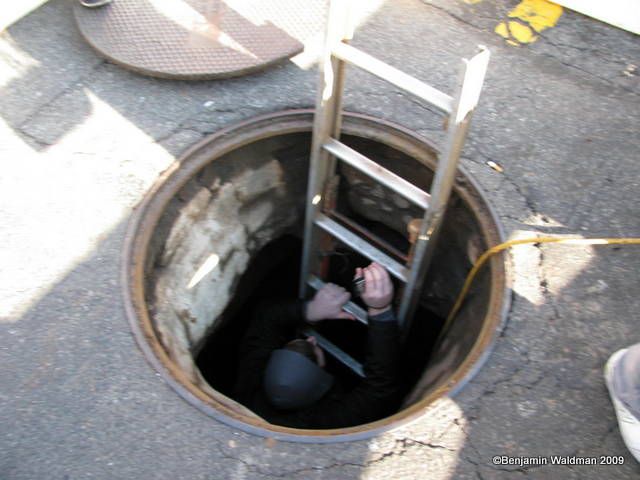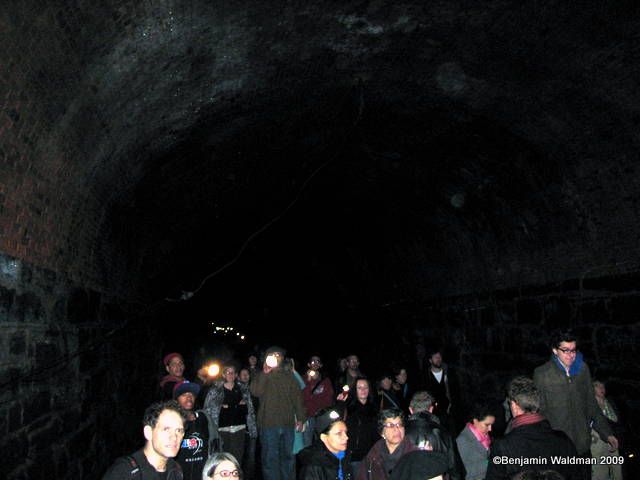✨You Can Touch the Times Square New Year's Eve Ball!
Find out how you can take home a piece of the old New Year's Eve ball!


Back in 1844 when the Atlantic Avenue Tunnel was built, the City of Brooklyn was not one of the five boroughs. For the commuters of the Brooklyn and Jamaica Railroad, better known today as the LIRR, the Cobble Hill Tunnel was meant to reduce the congestion caused by a street-level train. In 1980, about 120 years since the City of Brooklyn had banned steam locomotives within city limits, ending the use of the tunnel, Bob Diamond stumbled upon the hidden underground gem. From 1980, he gave tours of the half-mile span to interested gawkers only to have his permit mysteriously taken away by the city in 2010.

The entrance to the tunnel, and Diamond’s tour, was a manhole cover right on the street.
These excerpts of contemporaneous news articles compiled by the Brooklyn Historic Railway Association explain some reasons for the building of an Atlantic Avenue subway tunnel. Most pressingly, the LIRR trains lacked the necessary brakes to run at street level. This led to many injuries and the death of two youths, leading for more public support for removal of the LIRR train at street-level. When the ordinance that banned steam engines on the streets was passed, a necessary compromise was reached where the trains could use steam engines underground. It was also meant to improve “public convenience in respect to passage” as the official decision reads by Brooklyn’s Counsel in 1844. For these reasons, a tunnel connection was necessary to connect these passengers to the Manhattan-bound ferries at Atlantic Street.
The weird part about Bob Diamond rediscovering the tunnel and starting the Brooklyn Historic Railway Association in 1982 is that he was the only one who saw a possible use for the location at the time. Part of the reason why the Dept. of Transportation finally put an end to it in 2010 is just the sheer danger involved with this makeshift service. Adrianne Jeffries of The Verge writes, “He’d lug three plastic orange barricades out to the middle of Atlantic Avenue, pry off the manhole cover with a crowbar, and steady a thin ladder into the narrow shaft, the only entrance to the tunnel. Tourists would line up in the middle of the busy road, descending one by one into a tight passageway.” She also tells the story of Diamond digging out parts of the tunnel in exploration until he got his tour route. Oddly enough, this isn’t the first time Bob Diamond’s historic guides have been pulled from beneath him; remember those Red Hook Trolleys?

The tours drew a decent-sized crowd who was willing and nimble enough to crawl through the cavern’s tight spaces.
Though Bob Diamond and the BHRA may never find their way back into it, the Atlantic Avenue Tunnel still holds the Guinness World Record for Oldest Subway Tunnel. Barring some new development, that can not be taken away. The tunnel was also memorialized by New York poet Walt Whitman in the Brooklyn Daily Eagle while he was an editor–an excerpt can be found in this book.
Finally, a portion of the Atlantic Avenue tunnel can now be seen by the public in the hidden bar Le Boudoir. Read more about that here.
Read more from our Abandoned NYC series, which features some of our most popular posts. If you like vintage transportation, check out these photos from the Nostalgia Holiday events hosted by the MTA! Get in touch with the author @uptownvoice.
Subscribe to our newsletter